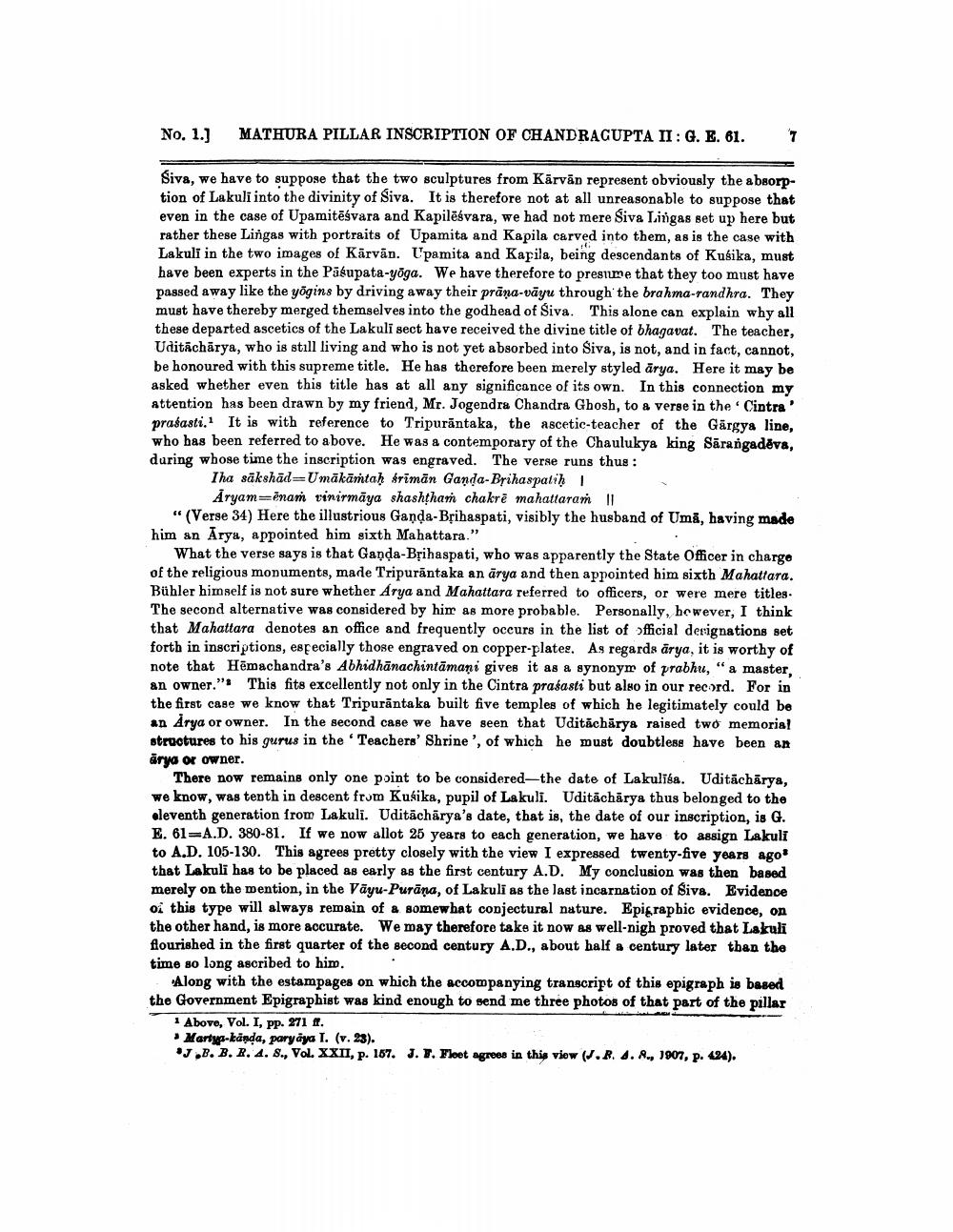________________
No. 1.)
MATHURA PILLAR INSCRIPTION OF CHANDRACUPTA II: G. E. 61.
7
Siva, we have to suppose that the two sculptures from Kārvān represent obviously the absorption of Lakuli into the divinity of Siva. It is therefore not at all unreasonable to suppose that even in the case of Upamitēśvara and Kapilēśvara, we had not mere Siva Lingas set up here but rather these Lingas with portraits of Upamita and Kapila carved into them, as is the case with Lakuli in the two images of Kārvān. t'pamita and Kapila, being descendants of Kusika, must have been experts in the Pasupata-yoga. We have therefore to presume that they too must have passed away like the yogins by driving away their prāna-vāyu through the brahma-randhra. They must have thereby merged themselves into the godhead of Siva. This alone can explain why all these departed ascetics of the Lakuli sect have received the divine title of bhagavat. The teacher, Uditācharya, who is still living and who is not yet absorbed into Siva, is not, and in fact, cannot, be honoured with this supreme title. He has therefore been merely styled arya. Here it may be asked whether even this title has at all any significance of its own. In this connection my attention has been drawn by my friend, Mr. Jogendra Chandra Ghosh, to & verse in the Cintra' prasasti. It is with reference to Tripurāntaka, the ascetic-teacher of the Gärgya line, who has been referred to above. He was a contemporary of the Chaulukya king Sārangadēva, during whose time the inscription was engraved. The verse runs thus :
Iha säkshäd=Umākārtah frimän Ganda-Brihaspatih
Aryam ēnam tinirmāya shashthan chakrē mahattaran 11 “ (Verse 34) Here the illustrious Ganda-Brihaspati, visibly the husband of Umå, having made him an Arya, appointed him sixth Mahattara."
What the verse says is that Ganda-Brihaspati, who was apparently the State Officer in charge of the religious monuments, made Tripurantaka an ārya and then appointed him sixth Mahattara. Bühler himself is not sure whether Arya and Mahattara referred to officers, or were mere titles - The second alternative was considered by him as more probable. Personally, however, I think that Mahattara denotes an office and frequently occurs in the list of official derignations set forth in inscriptions, especially those engraved on copper-plates. As regards ārya, it is worthy of note that Hēmachandra's Abhidhānachintāmani gives it as a synonym of prabhu, "a master, an owner." This fits excellently not only in the Cintra prasasti but also in our record. For in the first case we know that Tripurantaka built five temples of which he legitimately could be an Arya or owner. In the second case we have seen that Uditáchărya raised two memoria! structures to his gurus in the Teachers' Shrine', of which he must doubtless have been an arya or owner.
There now remains only one point to be considered the date of Lakulita. Uditācharya, we know, was tenth in descent from Kusika, pupil of Lakuli. Uditáchärys thus belonged to the eleventh generation from Lakuli. Uditāchārya's date, that is, the date of our inscription, is G. E. 61–A.D. 380-81. If we now allot 25 years to each generation, we have to assign Lakuli to A.D. 105-130. This agrees pretty closely with the view I expressed twenty-five years ago that Lakuli has to be placed as early as the first century A.D. My conclusion was then based merely on the mention, in the Väyu-Purāna, of Lakuli as the last incarnation of Siva. Evidence o this type will always remain of a somewhat conjectural nature. Epigraphic evidence, on the other hand, is more accurate. We may therefore take it now as well-nigh proved that Lakuli flourished in the first quarter of the second century A.D., about half a century later than the time so long ascribed to him.
Along with the estampages on which the accompanying transcript of this epigraph is based the Government Epigraphist was kind enough to send me three photos of that part of the pillar
1 Above, Vol. I, pp. 271 f. • Martya-tanda, paryaya I. (v. 23).
1.1. B.R. 4. 8., Vol. XXII, p. 187. J. F. Fleet agress in this viow (J.R. 4. A., 1907, p. 194).




